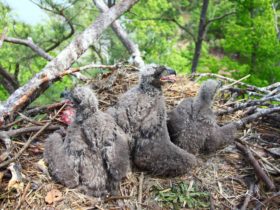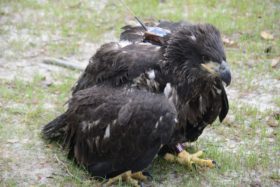Hope (the Whimbrel) update
Azalea vs. Hope (the Whimbrel)
August 15, 2009Azalea overnights in North Carolina
August 19, 2009Hope finally came to rest on the southern shore of St. Croix in the U.S. Virgin Islands on friday evening August 15 after flying non-stop from Hudson Bay in Canada, a distance of 5,720 km (3,550 mi). She is wearing a satellite transmitter weighing only 9.5 grams and expected to last one year or more before wearing out and falling off. Since being fitted with the transmitter by Libby Mojica on May 19, 2009 on the Eastern Shore of Virginia, Hope has flown 20,131 kilometers – over 12,000 miles!!!




11 Comments
How nice if there were a Whimbrel Airline that flew as efficiently. WTG Hope! 🙂
Absolutely amazing. What an incredible bird!
Wow! She’s a powerhouse! How wonderful it is that we have the technology to track her. Thank you, Dr. Lukei, for all the information you share with us.
Could this bird be mistaken for an Ibis by those who dont really know what they are?
Sam – I suppose it would be possible to confuse an Ibis and Whimbrel, but they are very different. There are four species of Ibis and all four are larger in size and weight of a Whimbrel, and Whimbrel have long pointed wings and Ibis don’t.
WOW – she must be tired! How can a bird possibly go all that way non-stop?
WOW…Hope sure is a traveller. I can’t get over how many miles she’s flown, that’s amazing. Reese, thanks for finding out how long she will be carrying the transmitter. How old are they when the transmitters are placed on them? Is the banding and the transmitter placement the same process as for the eagles?
Violet, DJ – I think I need to clarify the non-stop flight distance so that I don’t leave the impression that Hope flew 12,000 miles non-stop. She (Hope is an adult female) flew non-stop for 100 hours (August 10-15) from the upper shore of Hudson Bay to St. Croix, a flight of 5,720 km (3,550 mi).
Hope was trapped during her northward migration from her overwintering grounds somewhere in Central or South America. We do not know just where she came from. Maybe she will return there in the next few weeks. She was on her way to her breeding territory in northern Canada. Hope was banded and fitted with her state-of-the-art satellite transmitter all at the same time.
Thanks Reese. Actually, I didn’t think she flew all those miles non-stop. I guess what really impresses me is the distance birds fly period. Like the little hummingbird for instance that travels 500 to 600 miles across water to get to their South American winter habitats. Dave and I can hardly travel 2 to 3 hundreds miles without stopping for a break and these LITTLE guys fly across all that water to get to their winter home. It is truly amazing
Reese,
I wish Azalea’s maps were posted every three days as the data becomes available. I check and I check and I check. And then I check again! I’m sure I’m not the only one. And I know you’ve got other things to do. But this waiting and checking is torture! Thanks for all you do!
chris7,
If you are interested in more frequent updates, you can visit Azalea’s Tracking page to subscribe to automated daily project updates for Azalea. There are also other CCB eagle and whimbrel tracking projects there to browse.
-Carla Schneider
CCB Outreach